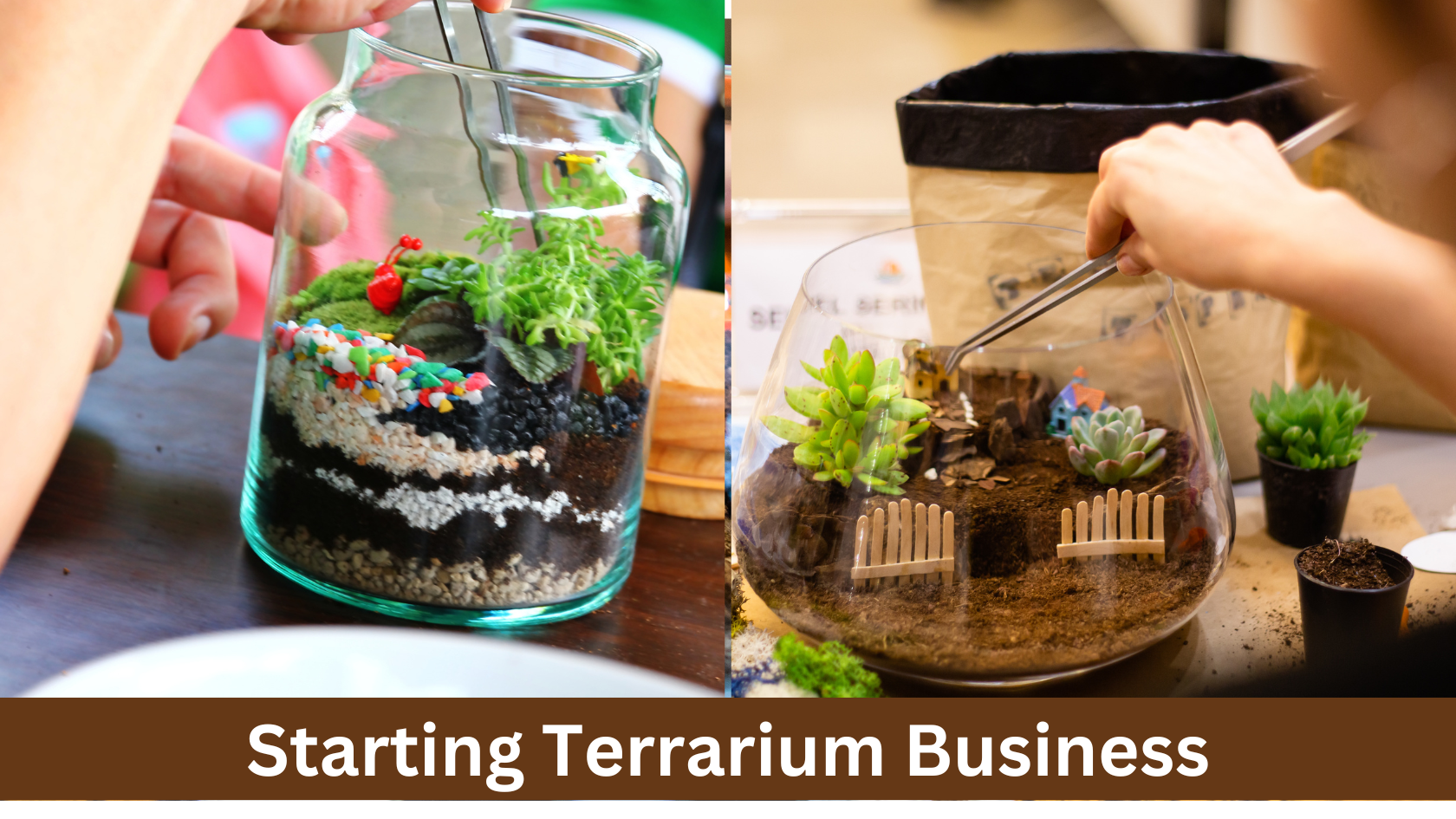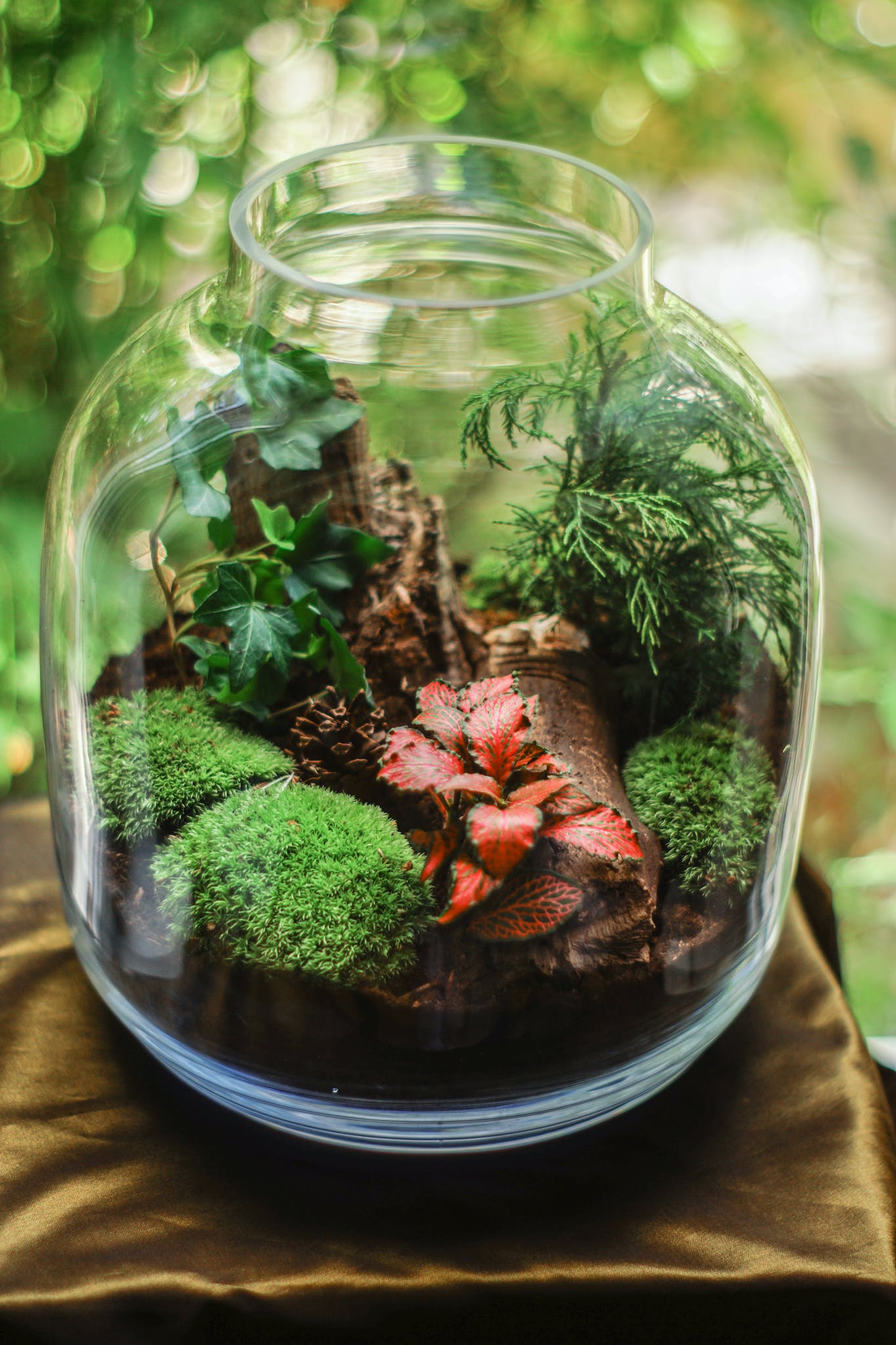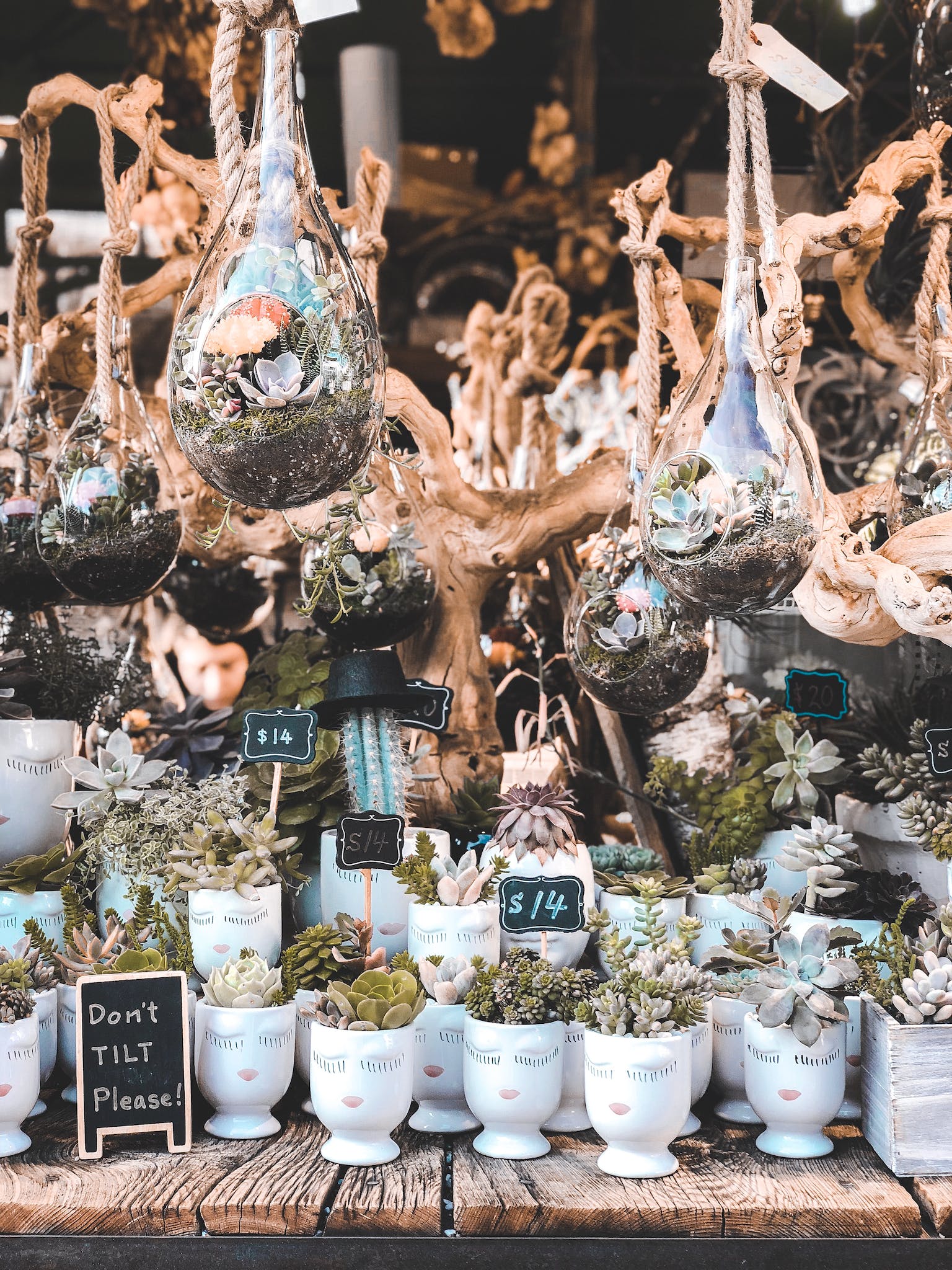How to Start Terrarium Business: Turn Your Hobby into a Profits

Terrariums have gained immense popularity as decorative indoor gardens, becoming a trendy hobby for many. If you’re a terrarium enthusiast, why not transition from being a hobbyist to an entrepreneur? This ultimate guide will walk you through the steps, from making a terrarium to selling it successfully, helping you establish a small business that thrives in the world of indoor plants.
If you want to start selling terrariums
Understanding the World of Terrariums
Terrariums come in various types, with closed and open terrariums being the most common. Closed terrariums, sealed to create a self-sustaining ecosystem, are perfect for low-maintenance indoor gardens. To start your business, choose the type of terrarium that aligns with your interests and market demands.
When it comes to plants, succulents are popular choices due to their resilience and decorative appeal. You can also explore using ferns, carnivorous plants, or other low-maintenance foliage. Understanding the different types of plants available will enable you to create diverse and appealing terrariums.
Exploring Popular Terrarium Plants and Succulents
Creating a terrarium that sells involves creativity and skill. Begin by gathering the necessary supplies. You’ll need a glass container, potting soil, pebbles, and decorative elements like moss and small figurines. Start by layering the bottom with pebbles to ensure proper drainage, followed by activated charcoal to keep the terrarium fresh.
Building terrariums is an art. Incorporate decorative elements, personalize designs, and experiment with various plants and moss to create visually appealing terrariums. You can find supplies at local nurseries, home improvement stores like Home Depot, or even online retailers.
Different Types of Terrariums: Open vs. Closed Terrariums
Open Terrariums:

Open terrariums are perfect for those in small spaces or anyone looking for a low-maintenance indoor garden. They’re easy to make, often using terrarium kits, making them a great choice for beginners. These terrariums work best for individuals searching for a new, hassle-free houseplant option and can be a potential income stream for business owners.
Closed Terrariums:

Closed terrariums create self-sustaining environments for plants, ideal for those living in dry climates. They’re also customizable and attract customers looking for unique, handmade décor items. Whether selling online or in-person, understanding your customer base and marketing your terrariums effectively is key to success.
Choosing the Right Terrarium for Your Business Niche
Selecting the appropriate terrarium style is crucial when establishing your small business.
Small Terrariums: A DIY Delight
For those keen on simplicity and accessibility, small terrariums are the way to go. These miniature indoor gardens are easy to make and often quite affordable, making them an excellent choice for beginners. Small terrariums are perfect for potential customers looking to try their hand at DIY projects or those wanting one of the low-cost and straightforward way to get started with indoor gardening.
Selling Small Terrariums at Local Markets
Small terrariums find their niche at local events like farmer’s markets and pop-up shops. These venues attract customers who appreciate unique, botanical-inspired items that add a touch of nature to their living spaces. When marketing these small terrariums, emphasize their charm and the ease of maintenance to attract buyers interested in a low-maintenance, nature-inspired addition to their homes.
Large and Intricate Terrariums: Perfect Gifts and Home Decor
For business owners searching for a standout product, larger and more intricate terrariums are the answer. These creations, meticulously crafted with attention to detail, make exceptional gifts and elegant home decor. When marketing these terrariums, underscore their potential as thoughtful gifts for special occasions. Drawing inspiration from the enchantment of botanical gardens, these terrariums are tailored for customers seeking an elegant and eye-catching addition to their spaces.
Appealing to a Broad Audience with Versatile Terrariums
To maximize the appeal of these more elaborate terrariums, position them as versatile decor items that can thrive in various lighting conditions, including both direct and indirect sunlight. Providing care tips and guidance on maintenance can boost customer satisfaction and encourage repeat business or recommendations to friends and family. Understanding your target audience and aligning your terrarium designs with their preferences will set your business apart and establish it as a top choice for those seeking nature-infused home decor.
How to Sell Terrariums: A Business Blueprint
Your hobby can be more than just a pastime; it can be a source of income. In this step-by-step guide, we’ll explore how you can transform your love for crafting terrariums into a profitable business.
Step 1: Perfect Your Craft
Before you start selling terrariums, it’s essential to ensure your creations are top-notch. Hone your terrarium-making skills by experimenting with various plant combinations, container designs, and decorative elements. Learn the nuances of plant care, moisture levels, and design aesthetics. Remember, the more unique and eye-catching your terrariums, the more likely they are to attract customers.

Step 2: Define Your Niche
Terrariums come in all shapes and sizes, and different styles cater to different audiences. Consider what niche you want to target. Are you interested in open terrariums, closed terrariums, or specific themes like succulent gardens? Define your niche to stand out in the market and attract the right customers.
Step 3: Source Quality Supplies
To create high-quality terrariums, you need the best supplies. Research reputable suppliers for glass containers, potting soil, pebbles, activated charcoal, and various types of plants. Ensure your suppliers provide top-notch materials that enhance the longevity and appeal of your terrariums.
Step 4: Set Up Your Workspace
Designate a workspace for your terrarium business. Ensure it’s well-lit and organized, with all the necessary tools and materials at hand. A dedicated space allows you to work efficiently and keeps your terrarium-making process streamlined.

Step 5: Legalities and Regulations
Starting a business involves legalities. Register your business, obtain any necessary licenses or permits, and ensure you comply with local regulations. You might also need to address tax-related matters. Consult with a legal or financial advisor if needed.
Step 6: Create a Brand Identity
A strong brand identity is essential to set your terrarium business apart. Design a memorable logo, select a unique business name, and develop branding that reflects the essence of your creations. Packaging is equally crucial; consider eco-friendly, eye-catching options to make your terrariums stand out.
Step 7: Pricing Your Terrariums
Pricing is a critical aspect of any business. Calculate the cost of materials, labor, and overhead to determine a fair price for your terrariums. Research competitors’ prices to ensure your rates are competitive. Remember, pricing can vary depending on your target market and the uniqueness of your products.
Step 8: Establish an Online Presence
In today’s digital age, an online presence is essential. Create a website or use platforms like Etsy to showcase your terrariums. High-quality photos and detailed descriptions will help potential customers understand the beauty and care requirements of your creations.
Step 9: Marketing Your Terrariums
A well-thought-out marketing plan is crucial. Utilize various marketing channels, including social media, to build visibility. Collaborate with influencers or bloggers who share your niche to expand your reach. Participate in local craft fairs or markets to showcase your terrariums in-person.
Step 10: Provide Excellent Customer Service
Satisfied customers are more likely to return and recommend your products. Offer prompt responses to inquiries, ensure safe and secure packaging for shipping, and include care instructions with your terrariums. Building strong customer relationships can be a key factor in your business’s success.
Step 11: Evolve and Expand
As your terrarium business grows, consider diversifying your product line, hiring help, or exploring wholesale opportunities. Keep experimenting with new designs and plants to cater to changing market trends.
By following these steps, your terrarium hobby can evolve into a profitable venture. Turning your passion into a business requires dedication, creativity, and a strong work ethic, but it can be incredibly rewarding both personally and financially.
Selling Terrariums: Finding Your Market
When it comes to selling terrariums, understanding your market is paramount. Identifying your target audience is the first crucial step. Nature enthusiasts and home decor lovers are often drawn to the charm of terrariums. Nature enthusiasts appreciate the botanical intricacies, while home decor lovers see them as stylish additions to their living spaces. By recognizing these distinct groups, you can tailor your marketing strategies to cater to their specific preferences and needs.
Utilizing Online Marketplaces: Etsy, Pinterest, and Other Platforms
In today’s digital age, online marketplaces play a pivotal role in reaching a broader audience. Platforms like Etsy and Pinterest are goldmines for artisans and entrepreneurs. Etsy, known for its handmade and unique products, is an ideal platform for showcasing your crafted terrariums. Utilize Pinterest, with its visual appeal, to create boards that highlight your creations. Additionally, consider exploring other platforms that align with your target demographic. Whether it’s Instagram for its visual storytelling or Facebook for community engagement, diversifying your online presence amplifies your terrariums’ visibility.
Establishing Your Unique Selling Proposition (USP) to Stand Out
In a market saturated with options, having a Unique Selling Proposition (USP) is your ticket to standing out. Your USP defines what sets your terrariums apart from the rest. It could be your focus on eco-friendly materials, personalized designs, or even themed terrarium collections. Emphasize your USP in your marketing materials, product descriptions, and customer interactions. A compelling USP not only attracts customers but also fosters brand loyalty, creating a niche for your terrarium business in the competitive market.
Final Thoughts
Finally, turning your terrarium hobby into a profitable venture is not just a dream; it’s a tangible goal with the right approach. Throughout this guide, we’ve explored the essential steps, from perfecting your craft to finding your unique market niche. By identifying your target audience, utilizing online platforms, and establishing a compelling Unique Selling Proposition (USP), you’re well on your way to transforming your passion into a successful business.
Embrace the spirit of entrepreneurship and the creative drive that fuels your terrarium hobby. Remember, every successful business started with a passionate individual taking the first step. Your dedication, combined with creativity and persistence, can turn your small terrarium creations into a thriving enterprise.
Take the First Step in Your Terrarium Business Journey
Now is the time to embark on your terrarium business journey. Take that first step with confidence, armed with the knowledge and inspiration gained from this guide. Start crafting, marketing, and connecting with your audience. Your terrarium business adventure awaits, filled with opportunities to grow, learn, and succeed. Good luck!
FAQs:
How can I start a terrarium business?
Starting a terrarium business can be a great way to turn your hobby into a profitable venture. Here are a few steps you can follow: 1. Research the market and identify your target audience. 2. Decide on the type of terrariums you want to sell (succulents, air plants, etc.) and gather the necessary supplies. 3. Create a business plan outlining your goals, marketing strategies, and financial projections. 4. Set up your online presence through platforms such as Etsy or create your own website. 5. Market your products through various channels like social media, Pinterest, or local boutiques. 6. Constantly evaluate and improve your products to meet the demands of your customers.
Is it difficult to make a terrarium?
Not at all! Making a terrarium is a fun and easy process. You simply need to choose a suitable container, fill the bottom with rocks or pebbles for drainage, add a layer of activated charcoal to prevent odors, place a layer of soil, and then arrange your plants. Finally, give it a light watering and place it in indirect light.
Can I make money by selling terrariums?
Absolutely! Many people are interested in purchasing terrariums as gifts or for home decoration. With a well-executed marketing strategy and high-quality products, you can definitely make a profit from selling terrariums.
How much time and money should I invest in starting a terrarium business?
A: The amount of time and money you invest in starting a terrarium business can vary depending on your goals and resources. It is recommended to start small and gradually expand as your business grows. Ultimately, the success of your business will depend on the effort you put into it.
Q: Can I resell terrariums I purchase from other suppliers?
Yes, reselling terrariums is a common practice in the industry. However, it is important to find reliable suppliers and ensure that the quality of the products meets your standards.
What are some marketing channels I can use to promote my terrarium business?
There are several marketing channels you can utilize to promote your terrarium business, including: – Social media platforms like Instagram and Facebook – Online marketplaces such as Etsy and eBay – Local craft fairs and markets – Collaboration with influencers in the niche – Word-of-mouth marketing through satisfied customers
What are some tips to help me succeed in the terrarium business?
Here are a few tips to help you succeed in the terrarium business: 1. Stay updated on the latest trends in the industry. 2. Offer a variety of terrarium designs to cater to different customer preferences. 3. Provide excellent customer service and prompt responses to inquiries. 4. Focus on creating unique and high-quality terrariums that stand out. 5. Build relationships with other business owners looking for new products to sell in their stores.
Do terrariums need direct sunlight?
No, terrariums do not require direct sunlight. In fact, direct sunlight can be harmful to the plants inside the terrarium as it can cause overheating. Indirect light or bright, filtered light is ideal for terrariums.
Can people living in apartments or small spaces have terrariums?
Absolutely! Terrariums are perfect for people living in apartments or small spaces as they require minimal space and can be placed indoors. They not only bring a touch of nature but also add a beautiful aesthetic to any living space.





